Note: At the end of this story there is a link to a survey to better gauge interest and support for a PCC dual enrollment program at LCHS:
http://bit.ly/lchsadvancedmath
Summary
On Wednesday August 15, 2018, the La Cañada Math Parents group hosted a meeting at the La Canada Public Library on the topic “Advanced Math Options at LCHS.” About 24 parents attended the presentation given by Sugi Sorensen and Ann Esin, parents of children at La Canada High School and La Cañada Math Parents members. The slides used during Sugi’s portion of the presentation are viewable below:
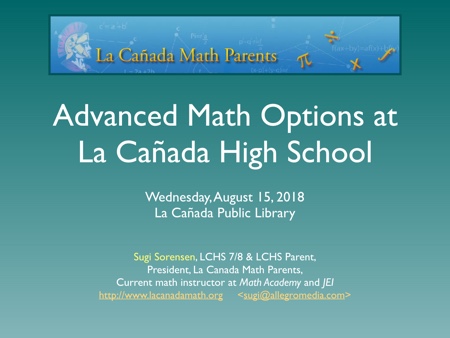
(click to see slides)
Background
Graduation Requirements:
Sugi reviewed the high school graduation requirements at the state and district level, then described the minimum requirements from the Cal State University (CSU) and University of California (UC) systems, as well as the generally known requirements from select private universities and elite Science, Technology, Engineering, and Mathematics (STEM) schools such as Caltech, MIT and Carnegie-Mellon:
- State & LCHS: 2 years of enrollment in math with at least Algebra 1 (i.e. LC Math 1).
- CSU: 3 years of math required including Algebra 1, Geometry, and Algebra II. 4 years recommended.
- UC: “three years of college-preparatory mathematics that include the topics covered in elementary and advanced algebra and two- and 3-dimensional geometry.” 4 yrs recommended.
- Select Private Universities: 4 years of math. 1 AP math.
- Elite STEM & Ivies: 4 years of math; 2 AP math.
The State of Math at LCUSD:
Sugi then provided some context as far as the state of advanced mathematics in the La Cañada Unified School District (LCUSD). First he shared a couple of selective indicators:
- Last year, no LCUSD students passed into the equivalent of Algebra I when they took the middle school math placement exam in May of 2017. (One student passed the 8th grade part of the exam in August, and another student was placed out of 8th grade Math Advanced into LC Math 1 Advanced after the first semester.)
- In Fall 2015, only 3.3% of LCUSD 7th graders enrolled in the equivalent of Algebra I or above.
- Meanwhile at Cupertino Union School District in Silicon Valley, 44% of 7th graders were in the equivalent of Algebra 1 or above in 2015.
- This is not by accident, rather part of a deliberate decision by LCUSD staff to slow down math acceleration in the district.
Sugi then showed the number of students known to have placed at least one year above grade level in math at the start of middle school, a metric sometimes used to measure the success of a district’s mathematics program. LCMP has been tracking the data over the past 7 years:
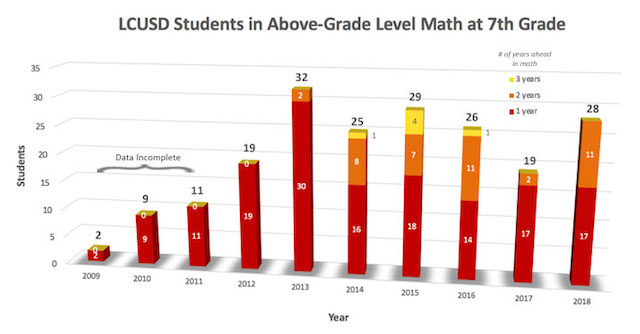
Current Math Pathways at LCHS
Sugi then described the official math pathways created by LCUSD for its students in middle and high school. There are currently two pathways, a College Prep Track and an Advanced College Prep Track:
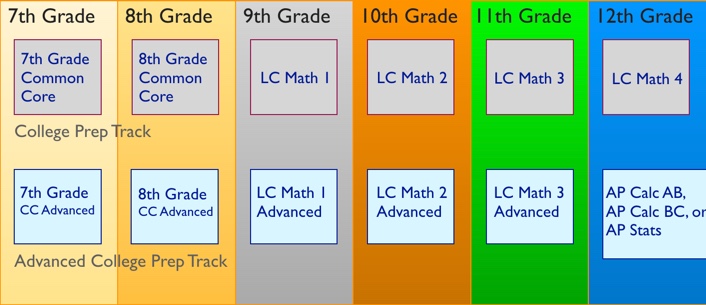
These are recommended pathways and students can take alternate courses from those prescribed, or stop at any time, as long as they meet the minimum graduation requirements. 7th Grade Common Core Math and 8th Grade Common Core Math, and their advanced siblings, contain what is traditionally understood as pre-Algebra. The LC Math 1, LC Math 2, and LC Math 3 courses, though their names imply they are integrated math courses, are actually traditional pathway courses containing Algebra 1, Geometry and Algebra 2 in the Common Core higher mathematics pathway:
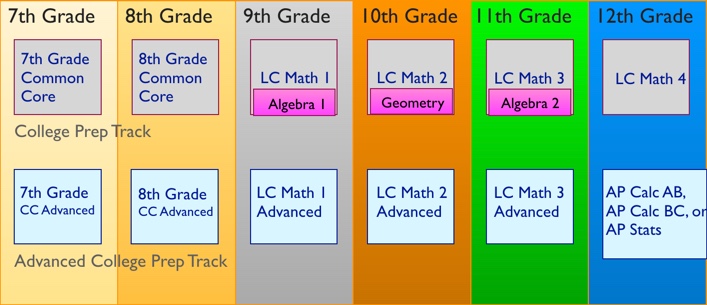
The LC Math 4 course contains pre-Calculus and trigonometry. Several meeting attendees noted that it is possible to skip LC Math 4 in 12th grade in the College Prep Track and take AP Calculus AB, though this is not recommended. The Advanced College Prep Track differs from the College Prep Track in that the LC Math 4 course is compacted into the LC Math 1 Advanced, LC Math 2 Advanced and LC Math 3 Advanced courses. Thus the Advanced Track represents a roughly 4-to-3 compaction over the regular College Prep Track in grades 9-12.
For more context, Sugi also showed what the two nominal pathways in LCHS looked like before the adoption of the Common Core State Standards in Mathematics (CCSS-M) in 2012:
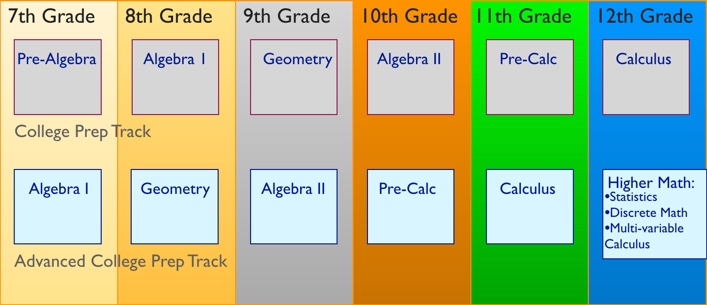
Note that the main difference between the pre-Common Core and current Common Core nominal pathway is that Algebra 1 was completed by all students in 8th grade before Common Core. This allowed all high school students who wanted to to complete Calculus prior to graduation from high school. CCSS-M moved Algebra 1 out to 9th grade in the regular pathway.
Sugi then showed the pathway for students who skip one year of math upon entry to middle school at LCHS:
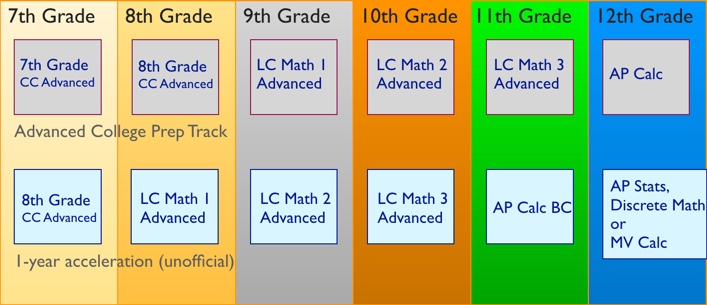
Note that the upper pathway is the Advanced College Prep Track, not the regular College Prep Track. The main takeaway is that students who pass out of the 7th Grade CC Advanced course take AP Calculus BC in 11th grade and are then faced with the choice of which higher math course to take as seniors. Though LCHS claims AP Statistics and Discrete Math are available, most students aspiring to select STEM schools prefer to take Multivariable Calculus in 12th grade.
Sugi then showed the choices available to students who are accelerated two years in math:
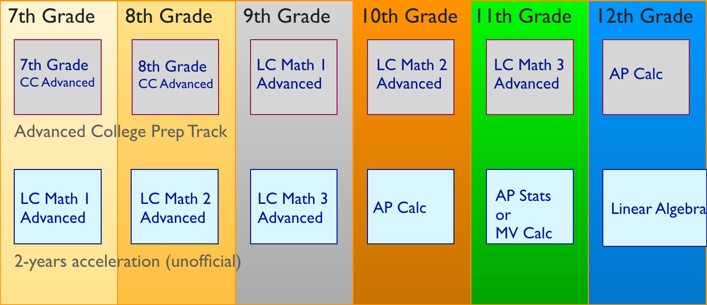
Math Courses Offered at LCHS
Sugi then listed all the math courses currently offered at LCHS in the 2018-19 school catalog, with the exception that the computer science and remedial math courses are left out. He also showed which teachers are teaching which courses:
- LC Math 1 P (MA5031): Carruthers, Cyhaniuk – 7 sections total
- LC Math 1 Adv P (MA5032): Gruss, Saavedra, Nunez – 7 sections
- LC Math 2 P (MA5033): Carruthers, Gruss – 4 sections
- LC Math 2 Adv P (MA5034): Nunez, Saavedra – 5 sections
- LC Math 3 P (MA5038): Leu, Quinn – 5 section
- LC Math 3 Adv P (MA5039): English – 4 sections
- LC Math 4 P (MA5036): Leu – 2 section
- Advanced Math Topics (MA5035): Quinn – 1 section
- AP Calc AB P (MA5013): Calm – 3 sections
- AP Calc BC P (MA5014): Calm – 2 sections
- AP Stats HP (MA5015): Gruss, Quinn – 3 section
- Discrete Math P (MA5037) – English – 1 section
The total number of sections taught for each class were also disclosed. Sugi pointed out that this is the last year Advanced Math Topics will be offered. Several questions were asked about the what was contained in certain courses, as well as what was known about certain teachers, particularly the new teachers –– Elizabeth Gruss, Juan Nuñez, and Jessica Quinn.
The Problem
The problem is that the highest level math course taught at LCHS is AP Calculus BC, which is taken by students who are either 1- or 2-years accelerated either in 10th or 11th grade and aspiring for admission to selective STEM colleges. The most desired class after AP Calc BC is multivariable Calculus, which is NOT offered at LCHS. As a result, students have to take multivariable Calc off-campus or online. Of the nine current LCHS students taking multivariable Calc this year, all are known to be taking the course at either Pasadena City College (PCC) or Glendale Community College (GCC). Students have in the past also taken multivariable Calc online through colleges such as Coastline Community College. The lack of availability of an on-campus multivariable Calculus course causes hardship to families who have logistical and planning issues taking the course after school at PCC or GCC.
Sugi then described recent efforts to ameliorate these hardships. He revealed that he had a meeting with LCHS Principal Ian McFeat and Assistant Principal Kip Glazer in June of this year to talk ostensibly about the math teacher problem at the high school (i.e. 9 teachers have left the middle and high schools in the past two years alone.) At that meeting, Sugi asked McFeat if the school would be willing to offer an advanced math course above AP Calc BC if there was enough student interest. McFeat answered in the affirmative, explaining that there would have to be sufficient interest, a teacher available to teach the course, a classroom available, and the course would have to be created and approved by the Governing Board and UC. Given McFeat’s affirmative answer, Sugi also revealed that he had contacted McFeat in July when he learned that there were at least nine current LCHS students planning to take multivariable Calc this school year, and PCC did not have any room available for high school students to enroll. In addition, McFeat was told that possibly 13 or more students would be in the same boat next year. McFeat had responded in July that he would look into it. McFeat never responded again after the vague initial response, thus compelling families seeking solutions this school year to enroll at PCC or GCC. Fortunately, as parent Ann Esin related, PCC then opened an additional section of multivariable Calc that accommodated her daughter and other LCHS students.
Sugi revealed that other districts offered better solutions to the same problem. South Pasadena HS had engaged in an agreement with PCC to bring a PCC instructor over to South Pasadena HS to teach multivariable Calc when there were sufficient numbers of students interested. In addition, Sugi revealed that other high performing districts in California such as Palos Verdes Peninsula USD, Cupertino Union USD, and Palo Alto USD all had similar agreements with local colleges to provide advanced math courses to their students.
A Better Solution at LCHS
Ann then talked about research she had recently conducted to provide a more permanent and desirable solution to the problem of a lack of advanced math courses at LCHS. First Ann talked about additional universities she found that offer multivariable Calc and other online advanced math courses to high schoolers. She identified two that she found most interesting, one offered by the University of North Dakota at a cost of $1,200, and another by University of Illinois at a cost of $1,636. Both courses are self-paced and preferable to the offerings of other universities because they offer a college semester course over nine months — corresponding to the high school year. Another parent in attendance in the meeting revealed that Stanford Online High School also offers multivariable Calc, but it costs ~$6,000.
Ann also revealed that she had spoken to Javier Carbajal-Ramos, Assistant Director of Educational Partnerships and Programs at PCC, and learned about a dual enrollment program that PCC had engaged in with nearby districts including South Pasadena USD and Pasadena USD that allowed high school students to take PCC college-level courses at their native high school, taught by PCC instructors. The dual enrollment program can offer any course, not just multivariable Calc, if there is sufficient student enrollment — namely 60% of a normal PCC class (i.e. 30 students.) That means at least 18 students would be needed to meet the threshold for PCC sending an instructor out to teach the course.
Even better, LCHS and LCHS families would not have to pay normal course fees for the courses. Apparently there is a program funded by the State of California that pays for the dual enrollment program. Thus, all that would be needed is for LCUSD to sign a dual enrollment agreement with PCC and LCHS students could then theoretically take multivariable Calc (and potentially other courses) at LCHS taught by a PCC professor.
Among the several solutions discussed at the meeting, parents universally agreed that the PCC dual enrollment program seemed the most desirable for a multitude of reasons including cost, convenience, and the opportunity for all LCHS students interested in the same course to take it together. Discussion then focused on how to make this a reality at LCUSD. Anticipated obstacles were then discussed:
- A parent who had been presented with the same dilemma years ago with her older son, who is now in college, was told that at the time the Principal had offered a similar solution (i.e. offering a multivariable Calc course), but then never followed through.
- Another parent who was faced with the same problem was told that there was no need for the school to offer multivariable Calc because other higher math courses were available in the LCHS catalog, namely AP Statistics and Discrete Math. All agreed that these courses were sub-optimal for the STEM opportunities sought by these advanced students. As pointed out by a student in attendance, Discrete Math was taken only by students who either did not want to take or were recommended to avoid the AP mathematics courses.
- A parent asked what would happen if there were not 18 LCHS students available. Ann said that Javier of PCC had said that the course could be offered at LCHS, but any PCC student could theoretically take the course as well. It was anticipated that LCHS administration would probably have issues with strangers or older non-LCHS college students taking a college course on the LCHS campus. Another parent recommended approaching local private schools who also have AP Calc BC as the capstone math course in their catalog. A third parent disclosed that St. Francis HS would be one such school that would probably be interested in such a joint offering of multivariable Calc at LCHS since AP Calc BC was the highest course offered there. All agreed that this was a great idea that should be pursued.
At the conclusion of the meeting, the assembled attendees agreed that the PCC dual enrollment program offered the best path forward and should be pursued. Ann and Sugi agreed to arrange a meeting with Principal McFeat to present the plan. It was also agreed that some process should be developed to identify parents who support the idea and/or have students who might benefit from such a program. A parent pointed out that theoretically any student who is at least one year ahead of the Advanced College Prep track could benefit from such a program and the graph Sugi had presented earlier showing the number of students at least one year accelerated upon entrance to middle school indicated that the demand was already sufficient. All agreed that if such a program were made official and wider known, more students would do what was needed to take advantage of the higher math offering(s).
Advanced Math Special Interest Group
To better gauge interest and support in a PCC dual enrollment program at LCHS, an online Advanced Math Special Interest Group has been formed at the following URL:
http://bit.ly/lchsadvancedmath
Interested parents should complete the survey form above.